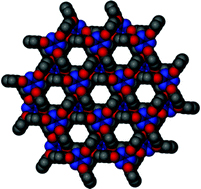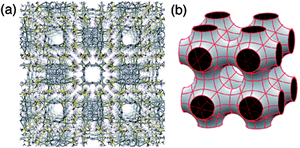 Metal–organic frameworks are materials containing coordination bonds between organic linkers and metal ions or clusters, exclusion of guest molecules in the structure can create a highly porous material with potential for gas storage, gas separation or catalysis. Other well studied nanoporous materials include zeolites, metal oxide molecular sieves, silica gels, activated carbons, covalent organic frameworks and organic network polymers.
Metal–organic frameworks are materials containing coordination bonds between organic linkers and metal ions or clusters, exclusion of guest molecules in the structure can create a highly porous material with potential for gas storage, gas separation or catalysis. Other well studied nanoporous materials include zeolites, metal oxide molecular sieves, silica gels, activated carbons, covalent organic frameworks and organic network polymers.
This highlight from Jian Tian, Praveen K. Thallapally and B Peter McGrail from Pacific Northwest National Laboratory reviews a very different class of nanoporous material, those comprised entirely of discrete organic molecules containing only weak non-covalent interactions. Often there is very close packing in the crystals (with voids or channels rarely exceeding 25 Angstroms) but under the right conditions solvents can be included within the structure in zero, one, two or three dimensional solvent accessible voids.
If the solvent can be easily removed from the structure highly porous crystalline materials can be made from organic compounds, the difficulty however is that upon desolvation the crystals often collapse into closely packed structures. This review discusses a wide range of structures which have been found to be stable as porous organic molecular materials, including crystalline structures with voids and amorphous solids with interconnected disordered pores. Read the CrystEngComm Hot Article (which is free to access for 4 weeks) for more details.
Porous organic molecular materials
Jian Tian, Praveen K. Thallapally and B Peter McGrail
CrystEngComm, 2012, Advance Article
DOI: 10.1039/C2CE06457J, Highlight












